Wałbrzych
Wałbrzych [ˈvawbʐɨx] (![]()
Wałbrzych | |
|---|---|
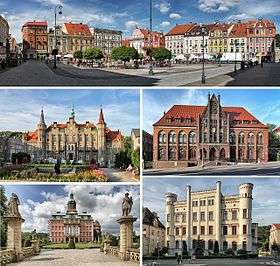
| |
 Flag  Coat of arms | |
 Wałbrzych 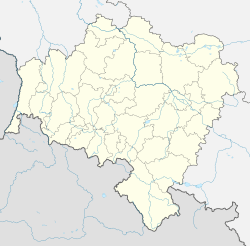 Wałbrzych | |
| Coordinates: 50°46′N 16°17′E | |
| Country | |
| Voivodeship | |
| County | city county |
| Established | 9th century |
| City rights | 1400 to 1426 |
| Government | |
| • Mayor | Roman Szełemej |
| Area | |
| • Total | 84.70 km2 (32.70 sq mi) |
| Elevation | 350 m (1,150 ft) |
| Population (31 December 2019) | |
| • Total | 111,356 |
| Time zone | UTC+1 (CET) |
| • Summer (DST) | UTC+2 (CEST) |
| Postal code | 58-300 to 58-309, 58-316 |
| Area code(s) | +48 74 |
| Car number plates | DB, DBA |
| Website | www |
Wałbrzych was once a major coal mining and industrial center alongside most of Silesia. The city was left undamaged after World War II and possesses rich historical architecture, among which the most recognizable landmark is the Książ Castle, the largest castle of Lower Silesia and the third largest in Poland.
Etymology
According to the city's official website, the early Polish name of the settlement was Lasogród ("forest castle").[2] The German name Waldenburg (also meaning "forest castle") referred to the castle Nowy Dwór (German: Burg Neuhaus), whose ruins stand south of the city; the name came to be used for the entire settlement.[3] It first appeared in the 15th century.[4] The modern Polish name "Wałbrzych" comes from the German name Walbrich, a late medieval linguistic variation of the older names "Wallenberg" or "Walmberg".[5]
History
Middle Ages
Polish sources indicate the city's predecessor, Lasogród, was an early medieval gord settlement[6] whose inhabitants engaged in hunting, honey gathering, and later agriculture. Lasogród eventually developed into a defensive fort, the remains of which were destroyed in the 19th century during expansion of the city.[7] However, some German sources say no archaeological or written records support notions of an early West Slavic or Lechitic settlement nor the existence of a castle before the late 13th century.[8] They also denounce the idea that during the Middle Ages the area of Wałbrzych was part of an unpopulated Silesian forest, known as the Silesian Przesieka.[9][10][11]
According to 17th-century Polish historian Ephraim Naso, Wałbrzych was a small village by 1191.[12] This assertion was rejected by 19th-century German sources[13] and by German historian Hugo Weczerka,[14] who says the city was founded between 1290 and 1293, and was mentioned as Waldenberc in 1305.[3] He places the city near Nowy Dwór (German: Neuhaus), built by Bolko I the Strict of the Silesian Piasts.[3] The city website, however, cites the building of the castle as a separate event in 1290.[2] A part of Nowy Dwór castle, a manor built in the 17th century, was destroyed in the 19th century.[15] Nevertheless, the region became part of Poland after the establishment of the state under the Piast dynasty in the 10th century and during the fragmentation of the realm, it was part of various Polish-ruled duchies, the last of which was the Duchy of Świdnica[16] until 1392, later it was also part of the Bohemian Crown and Hungary.
The settlement was first mentioned as a town in 1426, but it did not receive the rights to hold markets or other privileges due to the competition of nearby towns and the insignificance of the local landlords. Subsequently, the city became the property of the Silesian knightly families, initially the Schaffgotsches in 1372, later the Czettritzes, and from 1738, the Hochberg family, owners of Fürstenstein Castle.
Modern era
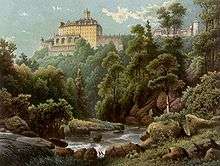
Coal mining in the area was first mentioned in 1536. The settlement was transformed into an industrial centre at the turn of the 19th century, when coal mining and weaving flourished.
As a result of the First Silesian War the city was annexed by the Kingdom of Prussia in 1742, and subsequently became part of Germany in 1871. In 1843 the city obtained its first rail connection, which linked it with Breslau (now Wrocław, Poland). In the early 20th century a glassworks and a large china tableware manufacturing plant, which are still in operation today, were built. In 1939 the city had about 65,000 inhabitants. During World War II the Germans established labour units for Italians from the Stalag VIII-A prisoner-of-war camp,[17] and two subcamps of the Gross-Rosen concentration camp, intended for Jews, located in the present Gaj and Książ districts.[18] It was conquered by the Soviet Red Army on 8 May 1945 - coincidentally, the day World War II in Europe ended.
After World War II, Waldenburg became part of Poland under border changes demanded by the Soviet Union at the Potsdam Conference and was renamed to its historic Polish name[19][20] Wałbrzych. Many of the Germans living in the city fled or were expelled. The town was repopulated by Poles expelled from former eastern Poland annexed by the Soviet Union, particularly from Borysław, Drohobycz and Stanisławów, as well as Poles returning from France and Belgium and from forced labour in Germany.[16] Wałbrzych was one of the few areas where a number of Germans[21] were held back as they were deemed indispensable for the economy, e.g. coal mining.[22] An ethnic German society has been maintained in Wałbrzych since 1957.[22] Greeks, refugees of the Greek Civil War, settled in Wałbrzych in the 1950s.[23]
The city was relatively unscathed by the Second World War, and as a result of combining the nearby administrative districts with the town and the construction of new housing estates, Wałbrzych expanded geographically. At the beginning of the 1990s, because of new social and economic conditions, a decision was made to close down the town's coal mines. In 1995, a Museum of Industry and Technology was set up on the facilities of the oldest coal mine in the area, KWK THOREZ. The 2005 the film Komornik was filmed in and around Wałbrzych.
In 2015 Wałbrzych became widely known due to the search for a allegedly buried Nazi gold train, which however was not found.
Sights
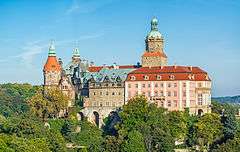


- Książ Castle (German: Schloss Fürstenstein), the largest Silesian castle, the third-largest castle in Poland behind Kraków's Wawel Castle and the Malbork Castle.
- Old Książ Castle (Stary Książ). Gothic ruins opposite (across a valley) Książ Castle
- Nowy Dwór Castle. The ruins of the castle Nowy Dwór (Ogorzelec) are on the top of Castle Hill (618 m)
- Czettritz Castle (1604–1628)
- Sanctuary of Our Lady of Sorrows. Gothic church, rebuilt into a Baroque style. Sanctuary of Our Lady of Sorrows placed in the center of Wałbrzych and is the oldest building of the city, called by the inhabitants "the heart of the city"
- Town Hall (Ratusz). A representative three-storey building maintained in the style of historical eclecticism, imitating gothic
- Palmiarnia (Palm House)
- Market square (renovated 1997–1999). A place where a weekly market took place in the past. In the years 1731-1853 its center was occupied by the Baroque town hall.
- Alberti Palace (District Museum)
- Guardian Angels Church. Built in 1898 in the neo-Gothic style as the Schutzengelkirche, in place of a previous church.
- Protestant church. Designed in the years 1785-1788 by Carl Gotthard Langhans, the founder of the Berlin Brandenburg Gate
- Mausoleum in Wałbrzych (Totenburg). Hitler's monument of "pride, glory and strength" commemorated the victims of World War I, in fact it was a place of cultivation of Nazi ideas
- Railway tunnel under the Little Wołowiec mountain. Counting 1,601 m (5,253 ft) is the longest railway tunnel in Poland
- Mountain Borowa (black mountain). The highest mountain in the Wałbrzyskie Mountains, with observation tower.
- Mountain Chełmiec. The second largest peak in the area. A monumental mountain in the shape of a dome that dominates the city. At the top there is an observation tower, 45 meter cross, and two radio-television masts
- Old Mine - Center for Science and the Arts (Stara Kopalnia - Centrum Nauki i Sztuki)is the biggest post-industrial tourist attraction in Poland, located in the former bituminous coal mine – Kopalnia Węgla Kamiennego "Julia" ("Thorez"). It covers the area of 4.5 hectares of historic post-industrial objects with authentic equipment, such as a machine park which has been secured and made accessible for visitors.
- Mining monuments in the city have been a lot of post-mining objects, among others, buildings, halls and mining towers.
City districts
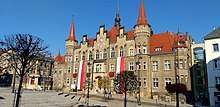
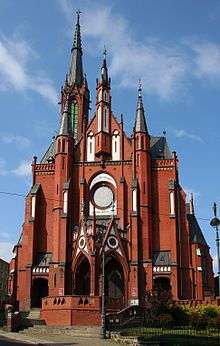
(German: Schutzengelkirche), built 1898

Including date of incorporation into the city
|
|
Education
- Angelus Silesius State University in Wałbrzych official site
- Wrocław Technical University in Wałbrzych official site
- Wałbrzyska Wyższa Szkoła Zarządzania i Przedsiębiorczości official site
- Ignacy Paderewski High School official site
- Hugo Kołłątaj High School official site
- Mikołaj Kopernik High School official site
- The city has a research center, Polish Academy of Sciences
Politics
Wałbrzych constituency
Members of Parliament (Sejm) elected from Wałbrzych constituency:
- Zbigniew Chlebowski, PO
- Henryk Gołębiewski, SLD
- Roman Ludwiczuk, PO (Senat)
- Katarzyna Mrzygłocka, PO
- Giovanni Roman, PiS
- Mieczysław Szyszka, PiS (Senat)
- Anna Zalewska, PiS
Sports
- Górnik Wałbrzych is a professional men's basketball club, two times Polish champions. Currently, it plays in the Polish 3rd league. Last time Górnik played in the Polish Basketball League (the Polish top basketball league) was in 2009.
- Górnik Wałbrzych is a professional men's football club playing in the Polish 4th league (5th level). It played in the Ekstraklasa (top tier) in the 1980s.
- Zagłębie Wałbrzych is a men's football club, which played in the Ekstraklasa in the 1960s and 1970s, finishing 3rd in 1971. It's currently competing in the amateur Klasa A.
- KK Wałbrzych (former Górnik Nowe Miasto Wałbrzych) – is a semi-professional men's basketball club playing in the Polish 3rd league.
- Victoria PWSZ Wałbrzych is a professional men's volleyball club playing in the Polish 3rd league.
There are many semi-professional or amateur football clubs (like Czarni Wałbrzych, Juventur Wałbrzych, Podgórze Wałbrzych, Gwarek Wałbrzych and one basketball club (KS Dark Dog is playing in the Polish 3rd league).
- LKKS Górnik Wałbrzych is a cycling club
- Wałbrzych native Sebastian Janikowski is a placekicker in the NFL.
- ASZ PWSZ Walbrzych -(women soccer)-(Level 1)-(Ekstraliga)-(Poland)- TBA
Media
- New Walbrzych Headlines official site
- Tygodnik Wałbrzyski official site
- www.walbrzych.info official site
- TV Zamkowa official site
- TV Walbrzych official site
- 30 minut – Gazeta która nie ma ceny ((Free) Newspaper – that does not have a price) official site
Notable people
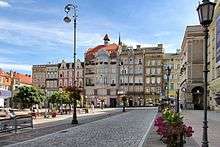
- Wolfgang Menzel (1798–1873), German poet, critic and literary historian
- Gerhard Menzel (1894–1966), German writer
- Abraham Robinson (1918–1974), German-Jewish-American mathematician
- Klaus Töpfer (b. 1938), German politician (CDU), born 1938 in Waldenburg
- Christian Brückner (b. 1943), German actor
- Marcel Reif (b. 1949), German soccer journalist
- Urszula Włodarczyk (b. 1965), Polish heptathlete
- Joanna Bator (b. 1968), Polish Nike Award-winning novelist, journalist, feminist and academic
- Piotr Giro (b. 1974), Polish-Swedish dancer and choreographer
- Leszek Lichota (b. 1977), Polish actor
- Krzysztof Ignaczak (b. 1978), Polish volleyball player
- Sebastian Janikowski (b. 1978), retired Polish-American football placekicker for the NFL Oakland Raiders and Seattle Seahawks
- Adrian Mrowiec (b. 1983), Polish footballer
- Bartosz Kurek (b. 1988), Polish volleyball player
Twin towns – sister cities
Wałbrzych is twinned with:[24][25]

.svg.png)



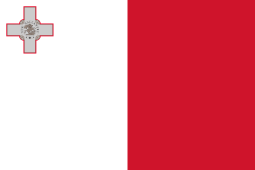



References
Bibliography
- Badstübner, Ernst; Dietmar Popp; Andrzej Tomaszewski; Dethard von Winterfeld (2005). Dehio – Handbuch der Kunstdenkmäler in Polen: Schlesien. München, Berlin: Deutscher Kunstverlag 2005. ISBN 3-422-03109-X.
- Petry, Ludwig; Josef Joachim Menzel; Winfried Irgang (2000). Geschichte Schlesiens. Band 1: Von der Urzeit bis zum Jahre 1526. Stuttgart: Jan Thorbecke Verlag Stuttgart. ISBN 3-7995-6341-5.
- Thum, Gregor (2003). Die fremde Stadt. Breslau 1945. Berlin: Siedler. ISBN 3-88680-795-9.
- Weczerka, Hugo (2003). Handbuch der historischen Stätten: Schlesien, Second Edition. Stuttgart: Kröner Stuttgart. ISBN 3-520-31602-1.
Notes
- "Local Data Bank". Statistics Poland. Retrieved 29 June 2020. Data for territorial unit 0265000.
- "Portal Urzędu Miejskiego w Wałbrzychu". um.walbrzych.pl.
- Weczerka, p.555.
- "Witamy w PORADNI JĘZYKOWEJ". us.edu.pl.
- Barbara Czopek, Adaptacje niemieckich nazw miejscowych w języku polskim, 1995, p.55, ISBN 83-85579-33-8
- Słownik geograficzno-krajoznawczy Polski Maria Irena Mileska 1994 page 781 Wydawn. Nauk. PWN, 1994
- "Historia Wałbrzycha". Wałbrzych City Office. Retrieved 2 April 2009.
- Vorgeschichtliche Funde innerhalb des Stadtgebietes sind spärlich und zweifelhaft in der Deutung, so daß eine frühe Dauersiedlung nicht angenommen werden kann. Für die Existenz einer "Waldenburg" im Bereich der Altstadt gibt es keinerlei Anhaltspunkte. Weczerka, p.555
- Auch der Grenzwald spricht dagegen. Weczerka, pp.416 and 555
- Badstübner, p.2.
- Petry, p.11.
- Kronika wałbrzyska Wałbrzyskie Towarzystwo Kultury, Państwowe Wydawnictwo Naukowe 1985 page 231
- Allgemeine Deutsche Biographie, Band 23, page 261, Markgraf, Duncker & Humblot, 1886
- Die Behauptung, die "Waldenburg" sei 1191 erbaut worden (Naso), ist nicht haltbar. Weczerka, p.555
- Weczerka, p.341.
- "Historia". Portal Urzędu Miejskiego w Wałbrzychu (in Polish). Retrieved 7 March 2020.
- Dorota Sula, Jeńcy włoscy na Dolnym Śląsku w czasie II wojny światowej, "Łambinowicki rocznik muzealny" 33, 2010, p. 66 (in Polish)
- "Subcamps of KL Gross- Rosen". Gross-Rosen Museum in Rogoźnica. Retrieved 7 March 2020.
- Polski Kalendarz Katolicki dla Kochanych Wiarusów Prus Zachodnich page 77 http://www.wbc.poznan.pl/dlibra/docmetadata?id=259791&from=&dirids=1&ver_id=&lp=2&QI=
- Katalog Prowincyonalnej wystawy przemysłowej w Poznaniu 1895 page 71 Werbebeilage http://www.wbc.poznan.pl/dlibra/docmetadata?id=130018&from=&dirids=1&ver_id=&lp=7&QI=
- Werner Besch, Dialektologie: Ein Handbuch zur Deutschen und allgemeinen Dialektforschung, Walter de Gruyter, 1982, p.178, ISBN 3-11-005977-0
- Stefan Wolff, German Minorities in Europe: Ethnic Identity and Cultural Belonging, Berghahn Books, 2000, p.79, ISBN 1-57181-504-X
- Izabela Kubasiewicz, Emigranci z Grecji w Polsce Ludowej. Wybrane aspekty z życia mniejszości, p. 117 (in Polish)
- "Miasta partnerskie". poznaj.um.walbrzych.pl (in Polish). Wałbrzych. Retrieved 28 February 2020.
- "Umowa z Cape Breton podpisana". poznaj.um.walbrzych.pl (in Polish). Wałbrzych. 14 January 2019. Retrieved 28 February 2020.
External links
| Wikimedia Commons has media related to Wałbrzych. |
| Wikivoyage has a travel guide for Wałbrzych. |
| Wikisource has the text of the 1911 Encyclopædia Britannica article Waldenburg. |
- Wałbrzych official city website
- Wałbrzych information website
- Jewish Community in Wałbrzych on Virtual Shtetl
- Wałbrzych - Waldenburg, Borowieck (tylko w 1945) na portalu polska-org.pl (in Polish)
- Local news website (pol)
- Wałbrzych photo gallery and local news
